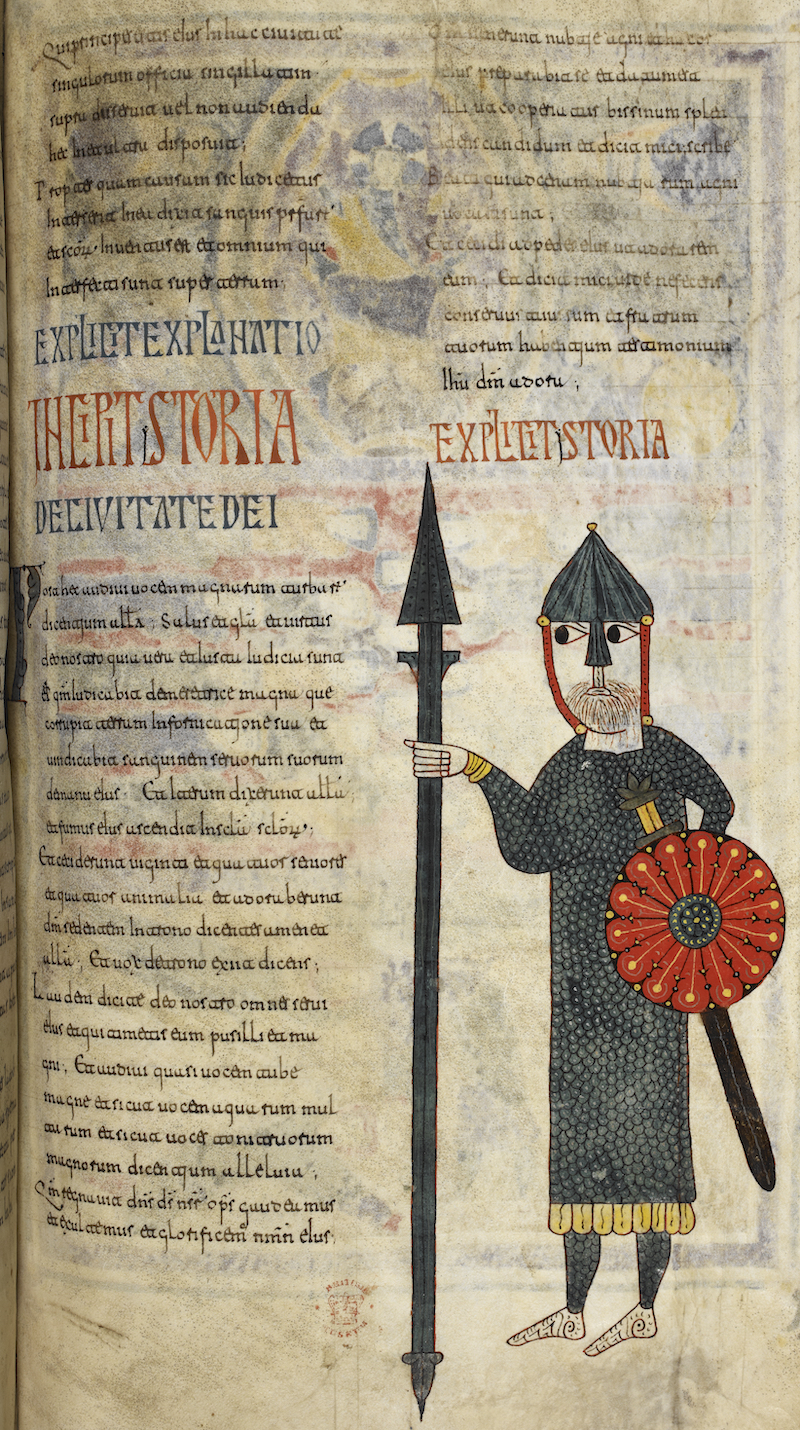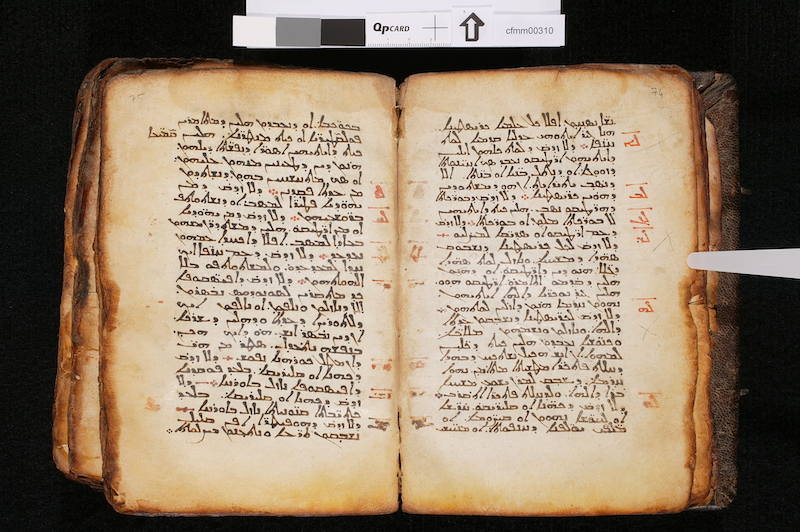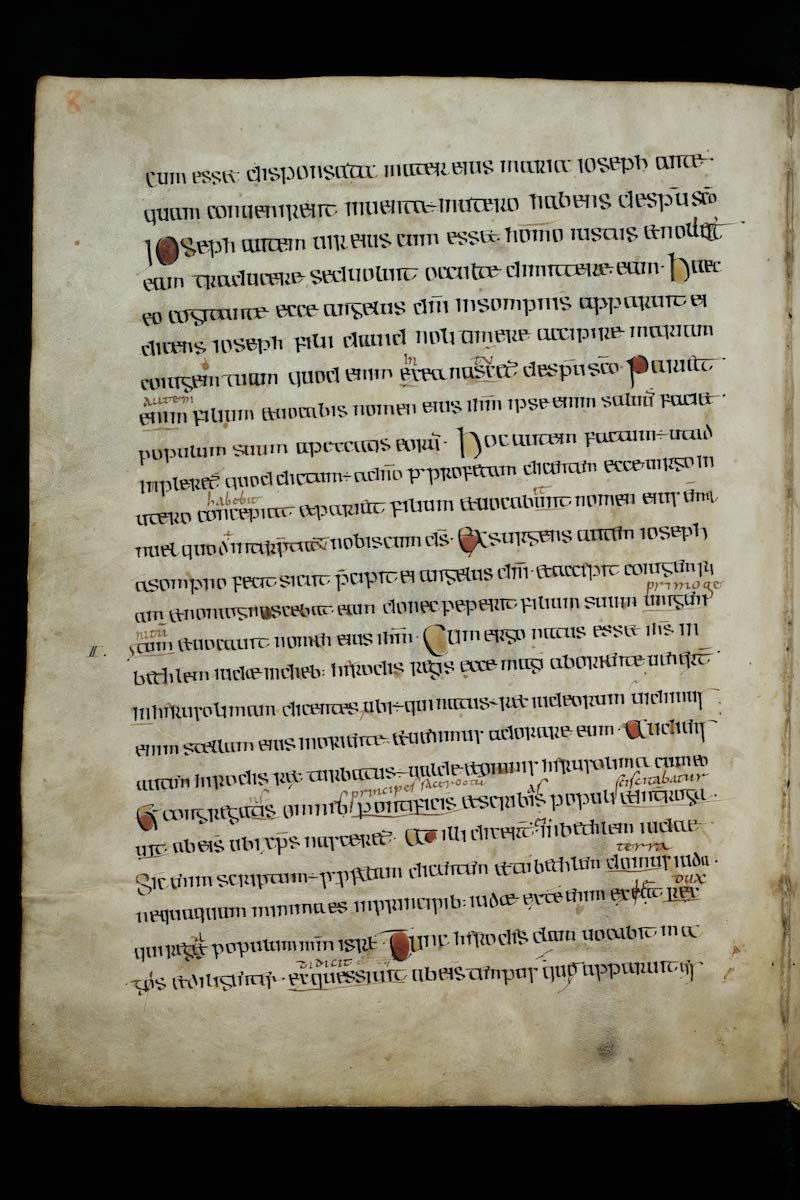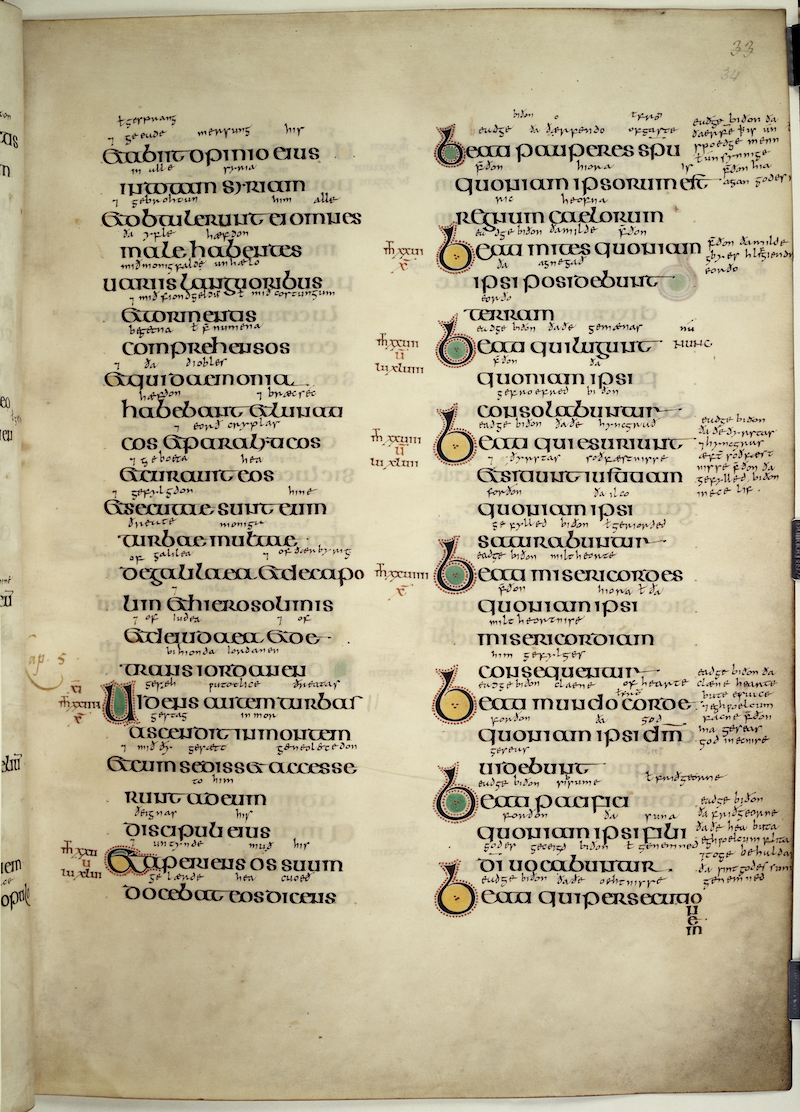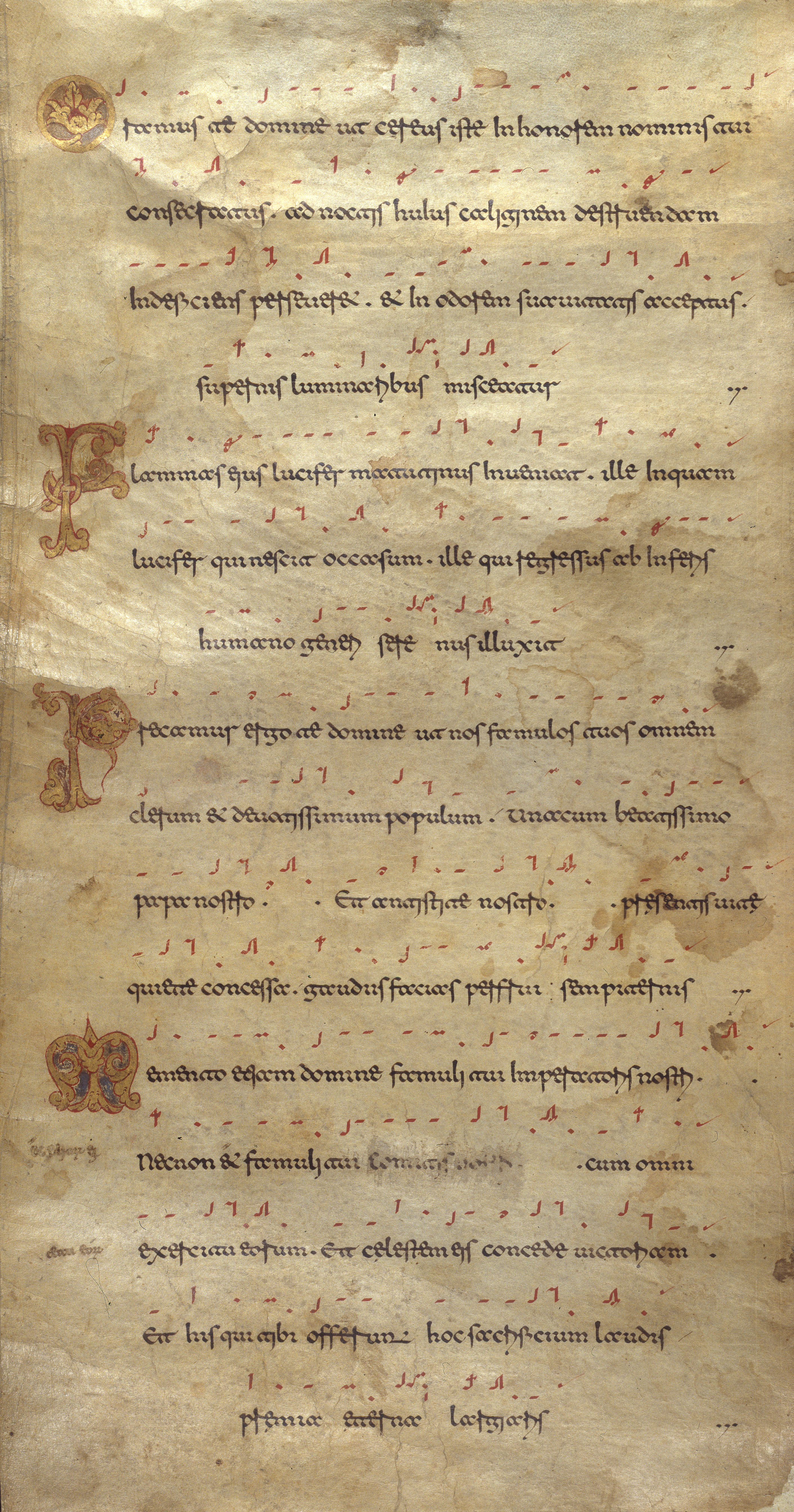
Beneventan, 11th century
-
Title
Exultet -
Language(s)
Latin -
Writing System
Roman -
Script(s)
Beneventan -
Country
Great Britain -
City
London -
Repository
British Library -
Shelf Mark
Add. 30337, fol. 8r -
Common Name
The Monte Cassino Exultet Roll -
Century
11th century -
Year Range
1075-1080 -
Provenance
Acquired by the British Museum in 1877 from antiquary and jeweller Alessandro Castellani -
Bibliography
E.A. Lowe, The Beneventan Script (1914).
Thomas Forrest Kelly, The Exultet Roll in Southern Italy (1996).
Francis Newton, The Scriptorium and Library of Monte Cassino 1058-1105 (1999).
-
External Facsimile
An Exultet roll is a very special sort of manuscript containing the text of the Exultet, or Easter Proclamation, which the deacon sings in praise of the Paschal candle at the Easter Vigil. The text is written on a long scroll, with text and illustrations facing opposite directions, so that while the deacon reads the text he is to sing, observers see the illustrations right-side up. The Exultet roll is associated with southern Italy and particularly with the Abbey of Monte Cassino, which was founded by St. Benedict of Nursia in the 6th century. Monte Cassino was therefore the home of Benedictine monasticism. It was also an enormously influential center of scribal practice for centuries. Its script, Beneventan, was dominant in southern Italy and the Adriatic region throughout the Middle Ages. This Exultet roll dates from the abbacy of Desiderius in the late 11th century, which is recognized as the golden age of the Monte Cassino scriptorium.
The Beneventan script is characterized above all by the broken minim, in which the letter part that in other scripts is the smallest vertical stroke is made of two lozenge-like diagonal strokes written with a broad pen held at an angle. As a result of the broken minim, Beneventan shares something of the angular look of Textualis, but its ductus is entirely different.
Beneventan shares several features with Visigothic: a a tall e that joins in ligature with following letters; the i-longa that resembles a lower-case l; an r with a very pointy top; and a t whose headstroke curves around to the left and resembles c. Among Beneventan's many ligatures, there are two forms of ti ligature: one in which the i has the form of j, and the t has its ordinary form, when the t is "hard", and one in which the crossstroke of t curves up and over to the right before joining the j-like i, for when the t is assibilated. Beneventan also has a distinctive ligature of pointy-topped r with a curvy i that descends below the baseline. See the Special Paleographic Features for examples of these and other ligatures.
The liberal use of ligatures in which letters join each other across the headline lends a strong horizontal emphasis to a line of writing in Beneventan. Most of the letterforms recognizably have their origin in Later Roman Cursive and are seen in the various sub-Roman and Pre-Caroline scripts, but Beneventan very much follows its own rules of usage and ductus.
The red marks above the text are neumes, which indicate the tune for the Exultet chant.
Acknowledgements: Described by Carin Ruff
Transcription
1 Oramus te domine ut cereus iste in honorem nominis tui
2 consecratus. ad noctis huius caliginem destruendam
3 indeficiens perseueret. et in odorem suauitatis acceptus.´
4 supernis luminaribus misceatur .,.
5 Flammas eius lucifer matutinus inueniat. ille inquam
6 lucifer qui nesciat occasum. ille qui regressus ab inferis
7 humano generi serenus illuxit .,.
8 Precamur ergo te domine ut nos famulos tuos omnem
9 clerum et deuotissimum populum.´ Una cum beatissimo
10 papa nostro. .Et antistite nostro. .prȩsentis uitȩ
11 quiete concessa. gaudiis facias perfrui sempiternis .,.
12 Memento etiam domine famuli tui imperatoris nostri.
13 Necnon et famuli tui [comitis nostri] .cum omni
14 exercitu eorum. Et cęlestem eis concede uictoriam.
15 Et his qui tibi offerun(t) hoc sacrificium laudis
16 prȩmia eterna largiaris
Paleographic Features
1. In line 1, the first letter after the illuminated O is an r. Note the very sharp top from which the shoulder descends to join up with the a that follows.
2. The m in the first word in line 1 is composed of three "broken" minims – the defining feature of Beneventan.
3. The final letter in the first word is is an s. Note how it bends up and over in a gentle curve, in contrast to the pointy-topped r earlier in the word.
4. The second word in line 1 is te. The t with the c-like left-hand stroke and the high e, with the two letters joining in ligature along minim height, are characteristic of Beneventan.
5. In the cereus, the sixth word in line 1, notice how the letters ere join with horizontal strokes along their middles, at minim-height.
6. The first word in line 2 is consecratus. Note particularly the sharp-topped r in the middle of the word, and the distinction between the a and the t immediately after it. a and t are easy to confuse with one another in this script.
7. The third word in line 2 is noctis, which contains a ti ligature. The j-shaped i is used when in ligature with t in this script, but unlike in Visigothic, it does not indicate assibilation of the t.
8. In the middle of line 2, huius contains an i-longa, a tall i. As in Visigothic, this form is used when the i stands for the semivowel "y" sound, as well as initially if another tall letter does not follow.
9. The first word in line 3 is indeficiens. The f and i are in ligature, with the i looking like a large comma. This is a typical Beneventan form.
10. At the end of line 3, you can see how a long series of broken minims and letters in ligature at minim height shape the script's aspect.
11. The second word in line 12 (the line that starts with an illuminated M) is etiam, and it contains the ti ligature that Beneventan uses for assibilated t. The t curves up and over so that it resembles a tall e. (All the other ti ligatures on this page are of the unassibilated type.)
12. The partially-erased text in line 13 appears to have been comitis nostri, "our Count," who was mentioned in the prayer after the Emperor.
13. The second word from the end of the second line from the bottom is sacrificium, which contains an ri ligature immediately followed by an fi ligature. Note the different forms i can take when in ligature with another letter in this script.
14. The last word on the page is largiaris. The first r joins up with a gi ligature with descending i, and the second r is in ligature with another i that takes the form of a long, sweeping curve.
